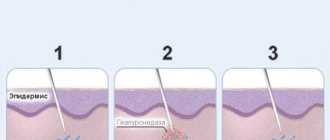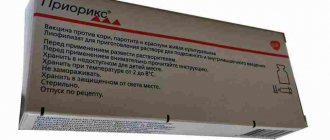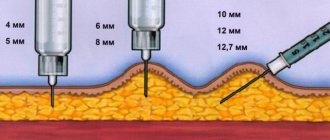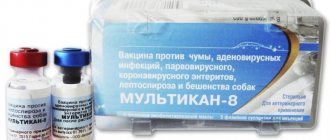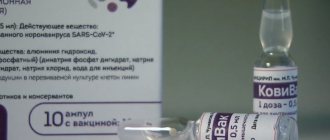Description and composition
Priorix vaccine - in Finland sold as a suspension in a pre-filled disposable syringe
Manufacturer: Belgian company GlaxoSmithKline Biologicals sa
In order to obtain a vaccine, measles and mumps viruses are grown separately on chicken embryos, and rubella viruses are grown on primary (diploid, containing only the chromosome set, artificially propagated) human cells.
Next, the viruses undergo a process of attenuation (weakening of pathogenic abilities). To do this, viruses are first grown under unfavorable conditions, then frozen, and then dried in a vacuum. Viruses treated in this way are no longer able to cause infection, but help develop immunity.
The Priorix vaccine is administered in accordance with World Health Organization recommendations regarding the safety of biological products.
1 dose contains:
- Schwarz – measles antigen;
- Jeryl Lynn – mumps antigen;
- Wistar RA 27/3 – rubella antigen;
- additional substances – lactose, mannitol, sorbitol molecules, amino acids, Action
In relation to the human body, viruses are foreign agents containing antigens. In response to their entry, the immune system produces antibodies (active defense elements). The strength of the virus is only enough to cause a full-fledged immune response, but this is not enough to cause the disease to develop.
Evidence-based studies of the vaccine have shown that after administration of the drug, intense immunity is formed. Thus, protective antibodies against measles infection were detected in 98% of vaccinated patients, mumps immunoglobulins – in 96%, and rubella antibodies – in 99%.
A repeat study of antibody concentrations one year after vaccination revealed that the amount against measles and rubella remained the same, and against mumps was 88%.
What you need to know about the Priorix vaccine?
The PRIORIX vaccination is used to develop stable immunity in children and adults to three viral diseases:
MEASLES.
It is characterized by an increase in temperature up to 40 degrees, damage to the upper respiratory tract and the appearance of a rash both on the skin and on the mucous membranes of the oral cavity. Infection occurs through contact with an infected person through saliva or sputum.
RUBELLA.
It is an infectious disease with a mild course, but can cause serious complications. Rubella is expressed in the form of increased fatigue, enlarged lymph nodes and a small rash against the background of moderate intoxication.
PAROTITIS.
The second name of the disease is mumps. The causative agent of mumps is transmitted by airborne droplets or contact through objects that have been contaminated with the saliva of a patient. The main signs of the disease are damage to the connective tissue structures in the glands.
- The Priorix vaccine is administered intramuscularly into the thigh or shoulder.
- The vaccine meets all the requirements of the World Health Organization.
- The vaccine can be used against three diseases at the same time!
- Immunity after vaccination is developed in 96-99% of children aged one year.
Make an appointment on WHATSAPP
Indications and vaccination calendar
Taking the Priorix vaccine means reliably protecting your child from infections that were considered epidemic before vaccination, because caused widespread illness.
The main indication for the use of Priorix is the prevention (prevention) of three infections: measles, mumps and rubella.
The Priorix vaccine is injected under the skin or into a muscle, but never into a vein. If the injection site is treated with alcohol, then it should evaporate (if the weakened virus is damaged by alcohol, then antibodies will not be produced).
The Russian national calendar provides for the following vaccination dates:
- 1 year;
- 6 years;
- girls 13 years old - vaccinated with MMR once or unvaccinated;
- at 15-17 years old;
- between 22 and 29 years old;
- thereafter every 10 years.
Another method of use indicated for emergency prevention is administration within 72 hours after contact with a person with measles. This use greatly eases the course of the infection.
The injection site is not protected in any way; you can moisten it with water.
Priorix
Release form, composition and packaging
Lyophilisate for preparing a solution for intramuscular and subcutaneous administration in the form of a homogeneous porous mass from white to slightly pink; the attached solvent is a clear, colorless, odorless liquid, free of visible impurities. 1 dose attenuated vaccine strain of measles virus (Schwarz) not less than 3.5 lg TCD50 attenuated vaccine strain of mumps virus (RIT4385, derivative of Jeryl Lynn) not less than 4.3 lg TCD50 attenuated vaccine strain of rubella virus (Wistar RA 27/3) not less than 3.5 lg TCD50. Excipients: neomycin sulfate (no more than 25 mcg), lactose, sorbitol, mannitol, amino acids.
The vaccine meets WHO requirements for the production of biological products, requirements for vaccines against measles, mumps, rubella and live combination vaccines. Solvent: water for injection - 0.5 ml.
Lyophilisate for preparing a solution for intramuscular and subcutaneous administration in the form of a homogeneous porous mass from white to slightly pink; the attached solvent is a clear, colorless, odorless liquid, free of visible impurities. 1 dose attenuated vaccine strain of measles virus (Schwarz) not less than 3.5 lg TCD50 attenuated vaccine strain of mumps virus (RIT4385, derivative of Jeryl Lynn) not less than 4.3 lg TCD50 attenuated vaccine strain of rubella virus (Wistar RA 27/3) not less than 3.5 lg TCD50 Excipients: neomycin sulfate (no more than 25 mcg), lactose, sorbitol, mannitol, amino acids. The vaccine meets WHO requirements for the production of biological products, requirements for vaccines against measles, mumps, rubella and live combination vaccines. Solvent: water for injection - 5 ml.
Clinical and pharmacological group: Vaccine for the prevention of measles, mumps and rubella.
pharmachologic effect
Live combined attenuated vaccine against measles, mumps and rubella. Attenuated vaccine strains of measles virus (Schwarz), mumps virus (RIT 4385, derivative of Jeryl Lynn) and rubella virus (Wistar RA 27/3) are cultivated separately in chicken embryo cell culture (measles and mumps viruses) and human diploid cells (rubella virus). Clinical studies have shown the high effectiveness of the Priorix vaccine. Antibodies to the measles virus were detected in 98% of those vaccinated, to the mumps virus in 96.1% and to the rubella virus in 99.3%. One year after vaccination, all seropositive individuals retained a protective titer of antibodies to the measles virus and rubella virus, and in 88.4% to the mumps virus. A certain degree of protection against measles disease can be achieved when the vaccine is administered to non-immune individuals within 72 hours of their contact with a person with measles.
Pharmacokinetics
Data on the pharmacokinetics of the drug Priorix are not provided.
Indications
- prevention of measles, mumps and rubella from the age of 12 months.
Dosage regimen
The vaccine is administered subcutaneously in a dose of 0.5 ml; IM administration of the vaccine is allowed. IV administration of the vaccine is not allowed! Priorix is administered to children at the age of 12 months , followed by a booster dose at the age of 6 years.
In addition, Priorix can be administered to girls aged 13 years who have not previously been vaccinated or who have received only 1 vaccination with monovalent or combined vaccines against measles, rubella and mumps.
Rules for preparing the solution
Immediately before use, add the contents of the supplied syringe or ampoule with solvent into the bottle with the drug at the rate of 0.5 ml per 1 dose.
Shake the bottle thoroughly until completely dissolved. The dissolution time of the drug should not exceed 1 minute. The dissolved drug is a clear liquid from light orange to light red. If the solution looks different or there are foreign particles, the vaccine is not used. A new sterile needle must be used to administer the drug.
When using a vaccine in a multi-dose package, a new syringe and needle must be used to withdraw the drug each time. The dissolved drug in multi-dose packaging should be used during the working day (within no more than 8 hours) provided it is stored in the refrigerator (at a temperature of 2° to 8°C). The drug must be removed from the bottle in strict compliance with the rules of asepsis. Under no circumstances should Priorix vaccine be administered intravenously.
Side effect
When using the vaccine, the incidence of adverse reactions was insignificant. Most often: hyperemia, pain and swelling at the injection site; slight increase in body temperature, rash. Rarely: febrile convulsions, swelling of the parotid glands. Extremely rare: symptoms characteristic of an upper respiratory tract infection (including rhinitis, cough, bronchitis), in addition - diarrhea, vomiting, anorexia, drowsiness, increased excitability, insomnia, acute otitis media, lymphadenopathy.
Contraindications
- primary and secondary immunodeficiencies (however, the drug can be used in persons with asymptomatic HIV infection, as well as in patients with AIDS);
- acute diseases and exacerbations of chronic diseases (for mild ARVI, acute intestinal diseases, vaccination is allowed immediately after the temperature normalizes);
- pregnancy;
- allergic reactions to previous administration of the drug;
- hypersensitivity to neomycin, any other vaccine ingredient and chicken eggs (however, a history of contact dermatitis caused by neomycin and an allergic reaction to non-anaphylactic chicken eggs is not a contraindication to vaccination).
Pregnancy and lactation
The drug is contraindicated for use during pregnancy. It is possible to use the vaccine during breastfeeding after assessing the expected benefits and potential risks. Vaccination of women of childbearing age is carried out in the absence of pregnancy and only if the woman agrees to be protected from conception for 3 months after vaccination.
special instructions
Caution should be exercised when administering the vaccine to individuals with a personal or family history of allergies and seizures. It should be taken into account that after administration of the vaccine, due to the possible risk of developing immediate allergic reactions, the patient should be under medical supervision for 30 minutes. Vaccination sites must be provided with anti-shock therapy, incl. solution of epinephrine (adrenaline) 1:1000.
Before administering the vaccine, you should make sure that the alcohol or other disinfectant has evaporated from the surface of the skin and the vial stopper, because these substances can inactivate attenuated viruses in the vaccine.
Overdose
Currently, no cases of overdose of Priorix have been reported.
Drug interactions
The Priorix vaccine can be administered simultaneously (on the same day) with DPT and DPT vaccines, live and inactivated polio vaccine, Haemophilus influenzae type b vaccine, hepatitis B vaccine, provided that the drugs are injected with different syringes into different parts of the body. Other live viral vaccines are prescribed at intervals of at least 1 month.
Priorix should not be mixed with other vaccines in the same syringe. Priorix can be used for re-vaccination in persons previously vaccinated with another combined measles, mumps and rubella vaccine or corresponding monopreparations.
Children who have received immunoglobulins or other human blood products are vaccinated no earlier than 3 months due to possible ineffectiveness as a result of the effect of passively administered antibodies against the measles, mumps and rubella vaccine viruses.
If immunoglobulin (blood product) was administered earlier than 2 weeks after vaccination, the latter should be repeated.
If it is necessary to perform a tuberculin test, it should be carried out either simultaneously with vaccination or 6 weeks after it, since the measles (and possibly mumps) vaccination process can cause a temporary decrease in the sensitivity of the skin to tuberculin, which will cause a false negative result.
Storage conditions and periods
The vaccine, complete with solvent, should be stored and transported at a temperature of 2° to 8°C. The vaccine, packaged separately from the diluent, should be stored and transported at a temperature of 2° to 8°C.
The solvent, packaged separately from the vaccine, should be stored and transported at a temperature of 2° to 25°C; Freezing of the solvent is not allowed. The shelf life of the vaccine is 2 years, the shelf life of the solvent is 5 years. The vaccine and diluent should be kept out of the reach of children.
Contraindications
Priorix vaccination is allowed when the immune system is normally active. With the permission of a doctor, vaccination is allowed even for HIV-positive patients in the absence of clinical symptoms.
Administration of the vaccine is contraindicated in the following conditions:
- acute infectious diseases (intestinal, respiratory) - administration of the vaccine is permitted after persistent relief of fever;
- any gestational age;
- previously recorded fact of allergy to Priorix;
- intolerance to any component of the vaccine.
If you are intolerant to chicken eggs or neomycin, if there has been no anaphylactic reaction, the drug can be administered.
For breastfeeding women, the decision to vaccinate is made individually.
When planning a pregnancy, the period between vaccination and conception should be at least 3 months.
The cost of vaccination with Priorix in Finland is 150 euros.
Side effects
The most common of all those described are rash, swelling and redness at the injection site, fever
Hyperthermia (high temperature) is observed in 40% of vaccinated people. This reaction is considered normal because it indicates the presence of an immune response.
In one-year-old children, hyperthermia can occur on the 9-10th day due to the fact that only by this time do babies develop antibodies.
In adults, post-vaccination arthritis is possible, and the likelihood increases with age.
Other complications - meningitis, encephalitis, pneumonia, myocarditis, toxic shock - are described in isolated cases (1 case per million vaccinated).
In general, the vaccine is an effective method of prevention with a high level of safety.

